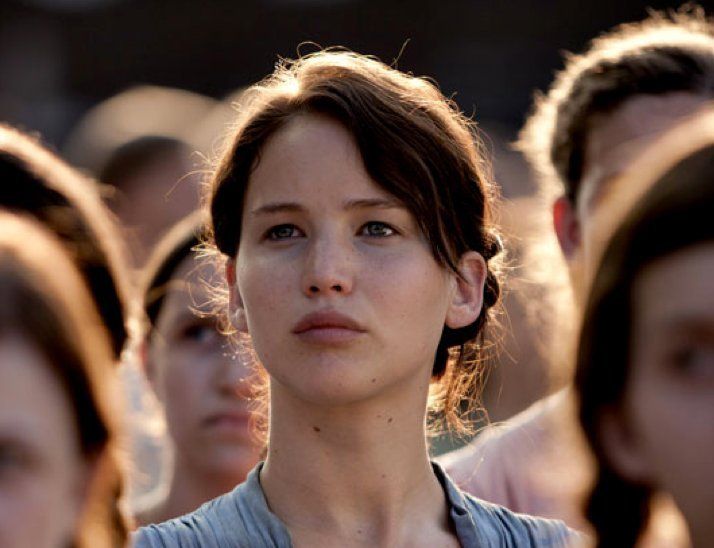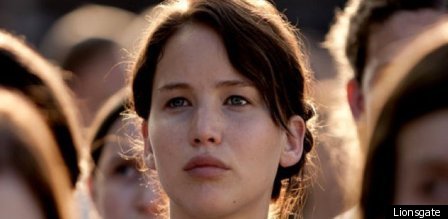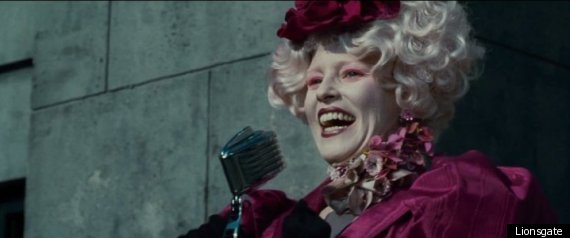
When it was announced that Jennifer Lawrence (known for her lead role in the oscar-nominated movie Winter's Bone) would be playing Katniss Everdeen in The Hunger Games, the movie's official Facebook page was promptly covered in comments from protesting fans. "Too blonde" and "too old" were the most common cries from opponents -- in the book, Katniss has dark hair and is only 16 years old, while Lawrence is 21 -- but the strongest reason against casting Lawrence was that her face is too soft, too "nice."
In the book, Katniss takes care of her entire family after her mom slipped into dementia when her father died in a horrific coal-mining disaster. Katniss is known for being hard as nails, and Lawrence is a little too movie-star-beautiful to be completely plausible in the role. After all, Katniss's family nearly starved to death when she was still a child and the memory is still fresh in her mind. Anyone who's read the books knows her face would be unapproachable, almost scary -- it would be the face of someone who's known nothing but extreme stress, pain and hardship all her life.

The Reaping: Jennifer Lawrence as Katniss Everdeen in District 12
For the record, Suzanne Collins played an integral role in the casting process and was fully behind the choice to cast Lawrence as Katniss. On top of that, director Gary Ross (in an impressive show of humility) said that Lawrence was more important to making the movie than he was.
In that same vein, the decision to cast 22-year-old Australian actor (and boyfriend of Miley Cyrus) Liam Hemsworth as Gale Hawthorne may have also been more of a "Hollywood choice" than a decision based on faithfulness to the novel. Hemsworth is painfully attractive ("He's such a dreamboat," as a girl sitting near me at the screening said) and this would have been okay if many of the reasons why he's such a potent character in the book (his hunting and athletic prowess; his loyalty) were hardly written into the script, leaving him a flat, effete character.
Where the movie really nailed it in terms of casting is with Peeta Mellark, the kind, slightly-boring baker's son who is Katniss's partner in the gladiator event. Peeta is played by a 19-year-old Josh Hutcherson (The Kids Are All Right) whose portrayal of his character's adorable naivete and unbreakable good will is (almost?) more touching than anything Katniss ever does. (Other memorable roles include Stanley Tucci as Caesar Flickerman and, of course, Woody Harrelson as Haymitch Abernathy. And hopefully we'll have more Toby Jones in the next two movies!)
Where the movie really succeeds, though, is visually. Director Gary Ross (Big, Pleasantville) said when he was designing Panem's ampitheaters, he was thinking of its historical precedents, Tiananman Square and the Brandenburg Gate. (Although there's one scene -- when Katniss and Peeta make their first appearance in the Capitol -- that looked a little too much like the runway at Fashion Week in New York City. But maybe that's an apt comparison.)
Ross, working with production designer Philip Messina, created a world where the overarching problem of wealth inequality (that pervades literally everything here as it does in real life) is extremely visible and obvious just by looking at how the characters are dressed. In District 12 where Katniss is from, an impoverished coal-mining region, people dress the way they must have a hundred years ago. The women look particularly old-fashioned in simple frocks with lace around the necklines (although Katniss goes hunting in a cool-looking leather jacket, I'm willing to let that slide.)
Compare this to "the Capitol," which is both the seat of the regime and the home of the only wealthy citizens in the depraved nation of Panem. In the Capitol, where the people are both free from having to send their children off to be slaughtered and have the additional privilege of eating three full meals a day, no one wears neutral tones like brown or gray. They wear only garish colors that would never occur in the natural world, like neon yellow and a blinding shade of magenta. They have a pretentious manner of walking and they cackle when they laugh. Here lies another difference between movie and book: in the movie the Capitol residents are more amusing than despicable. 
Flamboyant costumes: in 'The Hunger Games,' the brighter your outfit, the more shallow you are. Effie Trinket (played by Elizabeth Banks) announcing which children were chosen to fight.
Ross and Messina made the decision to shoot the actual "Hunger Games" (which comprise most of the movie's 143 minutes) in the same region of western North Carolina where they filmed Katniss's hometown of District 12. In the book you get the sense that the Games are being played in an arena that is completely artificial and manufactured. But here the filmmakers chose (and I'm not sure why -- maybe it was cheaper) to shoot the Games in a natural environment. Surprisingly, this only increases the horror of the televised bloodbath. There's something about the forest that's just creepier than anything we can make with our hands.
Which brings me to my final point -- the violence. It's not until the actual "Hunger Games" begin (roughly 30-40 minutes into the movie) that the full morbid impact of the plot hits home. Suddenly we're watching children murder each other. We hear a boy's neck break; we watch a very cute twelve-year-old girl get speared in the chest. Collins (who comes from a military family) has said she hopes her books will teach kids both about the horrors of war and how TV can desensitize us to real human suffering. But these lofty goals may be out of the reach of most of the movie's adolescent viewers, who are likely to enjoy the dramatic story and its charismatic heroine more than they will ponder the damaging role of media in modern society. But for now, the story is good. Very good. And there are still two more movies with which to teach the lesson that comes across so strongly in the novels.